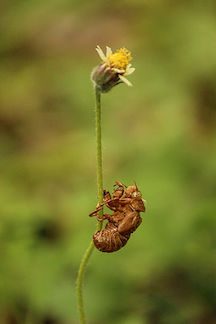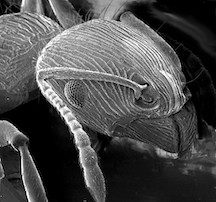The remains of insects are dated using the exoskeleton made of chitin, which is a fibrous substance made up of polysaccharides. Given the very small size and weight of the exoskeletons, they have historically been very difficult to date. However, with recent advances in Accelerator Mass Spectrometry (AMS) technology, very small amounts of chitin are required for accurate radiocarbon dating, e.g. 3-4 head capsules or 5-6 intact wing segments (Elias, 2010).
 The carbon-14 dating and analysis of insects have been of interest in archaeological and paleoenvironmental studies. For example, extensive work on insects and mummies has been completed by the Manchester Museum. The researchers have found insects resulting from the decay of the mummified bodies (e.g. Anthrenus museorum L.) as well as insects which were integrated into the mummy during the wrapping process (e.g. Chrysomya albiceps) (David, 1979), with dating recently confirmed using AMS technology (Panagiotakopulu et al. 2014). However, such studies have found that chemicals used in mummification processes (e.g. bitumen) can have an effect on the reliability of the insect chitin dates. In order to verify the dates of the insects, parallel dating of contemporaneous plant matter can be performed (Panagiotakopulu et al. 2014).
The carbon-14 dating and analysis of insects have been of interest in archaeological and paleoenvironmental studies. For example, extensive work on insects and mummies has been completed by the Manchester Museum. The researchers have found insects resulting from the decay of the mummified bodies (e.g. Anthrenus museorum L.) as well as insects which were integrated into the mummy during the wrapping process (e.g. Chrysomya albiceps) (David, 1979), with dating recently confirmed using AMS technology (Panagiotakopulu et al. 2014). However, such studies have found that chemicals used in mummification processes (e.g. bitumen) can have an effect on the reliability of the insect chitin dates. In order to verify the dates of the insects, parallel dating of contemporaneous plant matter can be performed (Panagiotakopulu et al. 2014).
The chitin material of insect exoskeleton is an ideal mineral for further isotopic analysis given its resistance to solubility and decay. When conditions allow, the atoms of nitrogen, carbon and strontium will remain stable within the chitin structure for millions of years, allowing for the reconstruction of past environments (Elias, 2010). Insects incorporate these isotopes into their structure through their diet and water intake, allowing them to be used to reconstruct variability in these isotopes over space and time.
 For example, chitin from monarch butterfly wings have also been analyzed for strontium (87Sr/86Sr) to study migration patterns by correlating wing chemistry with local soils and vegetation (Flockhart et al. 2015). Similar to other organisms, the nitrogen and carbon isotopes can also be utilized to reconstruct diet and trophic level. For example, Schimmelmann (2010) demonstrated that δ15N values in insect chitin are more positive with increasing trophic levels. Additional study topics include food preference (Adams et al. 2016), dietary niche (Santi-Júnior et al. 2018), natal origin (Flockhart et al. 2017) and disease transmission (Schmidt et al. 2011).
For example, chitin from monarch butterfly wings have also been analyzed for strontium (87Sr/86Sr) to study migration patterns by correlating wing chemistry with local soils and vegetation (Flockhart et al. 2015). Similar to other organisms, the nitrogen and carbon isotopes can also be utilized to reconstruct diet and trophic level. For example, Schimmelmann (2010) demonstrated that δ15N values in insect chitin are more positive with increasing trophic levels. Additional study topics include food preference (Adams et al. 2016), dietary niche (Santi-Júnior et al. 2018), natal origin (Flockhart et al. 2017) and disease transmission (Schmidt et al. 2011).
While different relationships have been confirmed between environmental variability and stable isotopes in insect chitin, these correlations can be complicated by changes in incorporation at different life stages and between different species (Gratton & Forbes, 2006).
Pretreatment – It is important to understand the pretreatment applied to samples since they directly affect the final result. You are welcome to include specific instructions on pretreatment or reporting.
To request for Radiocarbon Dating Costs, please use this form.
Other Service Available for Insect Chitin: Stable Isotope Analysis (δ13C and δ15N)
References:
Adams, M.O., Seifert, C.L., Lehner, L., Truxa, C., Wanek, W. & Fiedler, K. (2016) Stable isotope signatures reflect dietary diversity in European forest moths. Frontiers in Zoology, 13, 37.
David, A.R. Manchester Museum, (1979). Manchester museum mummy project: multidisciplinary research on ancient Egyptian mummified remains. Manchester University Press.
Elias, S.A., (2010). 14 Beetle Chitin Isotope Studies. Developments in Quaternary Sciences, 12, pp.219-222.
Flockhart, D.T., Brower, L.P., Ramirez, M.I., Hobson, K.A., Wassenaar, L.I., Altizer, S. et al. (2017) Regional climate on the breeding grounds predicts variation in the natal origin of monarch butterflies overwintering in Mexico over 38 years. Global Change Biology, 23, 2565–2576.
Flockhart, D.T., Kyser, T.K., Chipley, D., Miller, N.G. and Norris, D.R., (2015). Experimental evidence shows no fractionation of strontium isotopes (87Sr/86Sr) among soil, plants, and herbivores: implications for tracking wildlife and forensic science. Isotopes in environmental and health studies, 51(3), pp.372-381.
Gratton, C. & Forbes, A.E. (2006) Changes in δ13C stable isotopes in multiple tissues of insect predators fed isotopically distinct prey. Oecologia, 147, 615–624.
Panagiotakopulu, E., Higham, T.F., Buckland, P.C., Tripp, J.A. and Hedges, R.E., (2015). AMS dating of insect chitin–A discussion of new dates, problems and potential. Quaternary Geochronology, 27, pp.22-32.
Santi-Júnior, A.D., Botteon, V.W., Mastrangelo, T. & Moreira, M.Z. (2018) Trophic ecology of citrus pests based on stable isotope analysis. Scientia Agricola, 75, 504–508.
Schimmelmann, A., (2011). Carbon, nitrogen and oxygen stable isotope ratios in chitin. In Chitin (pp. 81-103). Springer, Dordrech
Schmidt, O., Dautel, H., Newton, J. & Gray, J.S. (2011) Natural isotope signatures of host blood are replicated in moulted ticks. Ticks and tick-borne diseases, 2, 225–227.
Tripp, J.A., Higham, T.F.G. and Hedges, R.E.M., (2004). A pretreatment procedure for the AMS radiocarbon dating of sub-fossil insect remains. Radiocarbon, 46(1), pp.147-154.
Photo Credits: Karthik Easvur (CC BY-SA 3.0) and USGS (Public Domain) via Wikimedia Commons
This entry was posted on Saturday, January 29th, 2022 and is filed under Radiocarbon Dating, Stable Isotope Analysis .